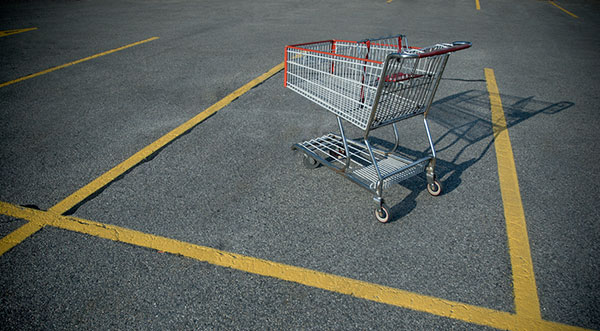For years I’ve noticed that there are always stray shopping carts littering the parking lot of one of the grocery stores near me. Yet right up the street, the other grocery store never has stray carts. They are always neatly stacked in the cart corrals. Both stores are in fairly affluent areas, both are nice stores. So I assumed that one store had better staff practices/policies, but I may have assumed wrong.
Tonight I read a fascinating article about social norms in a Scientific American blog that stuck me as both a blinding flash of the obvious (in retrospect) and at the same time really insightful relative to many things I notice daily. Like the neighborhood I drive through several times a week, that has gone from well taken care of to nearly blighted for no apparent reason. And the several strip malls on high traffic streets that lose one tenant, then two, then three, then seven. Areas once covered with graffiti that seem to morph into cool entertainment districts once one hip tenant moves in.
I’m sure there are economic aspects at play in many cases. But I recently talked to an owner of a nail salon in one such strip mall. She has a strong client base, good revenue, and reasonable rent yet felt she needed to move because so many other tenants had moved out of the strip mall. She thought people would question why she was there when everyone else seemed to be moving out.
As the Scientific American article pointed out.
Social norms fall into two general categories. There are injunctive norms, which drive our responses based on our perception of how others will interpret our actions. This means that we’re inclined to act in certain ways if we think people will think well or think poorly of us. And there are descriptive norms, where our responses are driven by contextual clues. This means we’re apt to mimic behaviors of others—so what we see or hear or smell suggests the appropriate/accepted response or behavior that we should display.
The article referenced a scientific study that tested behavioral responses against the manipulation of injunctive and descriptive norms to see if a violation of one norm would lead people to violations of other, unrelated norms. They used graffiti and litter and bicycles and fences. And saw very interesting results. The article is worth a read.

As to the shopping carts…the article outlined five categories of cart users:
- Returners. These people always return their carts to the receptacle regardless of how far away they’ve parked or what the weather is like. They feel a sense of obligation and/or feel badly for the people responsible for collecting the carts.
- Never Returners. People who never return their carts. They believe it’s someone else’s job to get the carts or the supermarket’s responsibility, and show little regard for where the carts are left.
- Convenience Returners. People who will return their carts if they parked close to the receptacle, or if they see a cart attendant.
- Pressure Returners. People who will return their carts only if the cart attendant is present or if the adjacent car’s owner is present, which means they don’t have an easy avenue for abandoning their carts.
- Child-Driven Returners. These are people with children who view it as a game to return carts, often riding them back to the receptacle or pushing them into the stacked lines.
Supermarkets can try and guide our behavior with receptacles or cart attendants, but they’re competing with our own self-serving goals, which in this case may be staying dry, keeping an eye on our children, or simply getting home as quickly as possible, and we’re being guided by the ways others behave on top of that. These goals can override the norm because the support provided by the supermarket—ironically—resets the situation before complete chaos is unleashed with carts running rampant in the parking lot. An attendant will most likely step in before that happens. So if we apply this definition of norms to our classification of cart returners, the injunctive norm applies the greatest pressure to Returners and Pressure Returners. These folks are concerned by what others will think of them on some level, and want to adhere to social rule mandating that the carts are returned. Descriptive norms are at play for Convenience Returners and Pressure Returners who are more inclined to act if there is precedent. These folks are more likely to return a cart if there are no carts parked haphazardly. The Never Returners and the Child-Driven Returners are two example of goal-driven actors, which means that they’re responding to a more individual need. These two are interesting as they’re on opposing ends of the spectrum but still demonstrate the ways an individual goal can work for or against a norm.
I’m a returner. Always. Even in the rain, snow, hail and wind. No matter how far away the cart corral is. What does that say about me?



